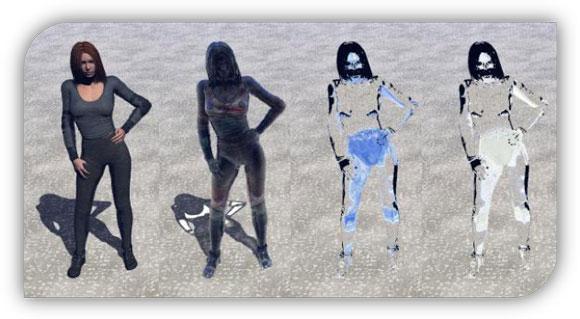Scientist Says Metamaterials and 3D Printing Will Lead To Invisibility Cloaks In His Lifetime
The world will get considerably more ‘transparent’ if work being done in a lab in Arizona comes to fruition.
Hao Xin, a professor of electrical and computer engineering, has discovered synthetic materials which might one day be used to build microscopes with superlenses and even ‘shields’ which could render military equipment and people invisible to the naked eye.
Working at the Millimeter Wave Circuits and Antennas Laboratory at the University of Arizona, Xin uses metamaterial building blocks and 3D printing to create startling results.
These metamaterials, which can be made via 3D printing from plastics, metals, and a variety of other substances, look a bit like porous plastic balls, tubes, and tiny copper wire circuit boards, but it’s their specialized geometrical patterns which give them their amazing properties. The metamaterial structures can bend waves of energy in unheard of ways so that they exhibit a property called ‘negative refraction.’
Yep, the structures are configured to bend a wave backwards, and the discovery could lead to advances like ‘super lensing’ and electromagnetic invisibility.
Xin’s work with energy conservation-based theory, full-wave simulation, and experimental measurement shows the 3D printed samples consisting of sub-wavelength building blocks with embedded microwave tunnel diodes exhibit a “band-limited Lorentzian dispersion” and simultaneously, a negative refractive index.
“Our work provides experimental evidence to the assertion that a stable net gain in negative-index gain medium is achievable,” Xin says. “It proposes a potential solution for the critical challenge current metamateiral technology faces in practical applications.”
According to Xin, the work represents a leap forward towards building what he calls “invisibility cloaks.”
 The findings have been published in a paper entitled “Microwave Gain Medium With Negative Refractive Index” in the journal Nature Communications.
The findings have been published in a paper entitled “Microwave Gain Medium With Negative Refractive Index” in the journal Nature Communications.
Imagine a scenario where looking at a person wearing a garment, built with specially-designed refractive properties, would be prevented from seeing the target depending on the refractive index distribution of the pattern.
Xin says sound waves, microwaves, light waves, or seismic waves can be manipulated by metamaterials with negative refraction.
“One of the biggest problems with metamaterials is that they produce energy loss. The waves decay as they pass through the artificial material,” Xin says. “We have designed a metamaterial that retains negative refraction but does not diminish energy.”
The synthetic material constructs do more than prevent energy loss. Xin says they actually cause energy gain, and at least in the case of microwaves, intensify the strength of waves as they passed through this novel material via embedded, battery-powered tunnel diodes and the advantages of micro-nanofabrication techniques.
Funded by the Air Force Office of Scientific Research, the metamaterials research was done with doctoral students in the Millimeter Wave Circuits and Antennas Lab.
One of those doctoral candidates, Adnan Kantemur, says the work provides a chance to study the ideas in practice and lets students actually make metamaterials rather than simply consider them analytically.
The team says the work has implications well beyond the microwave spectrum and could present opportunities in optics, acoustics, and relating to various types of radiation.
While the metamaterials are very much in the testing phase at this point, Xin says he’s confident they wildest applications of the discovery aren’t that far in the future.
“Invisibility cloaks will be a reality in my lifetime,” Xin says.
Do you believe technology like a 3D printed invisibility cloak will be available in your lifetime? Let us know in the 3D Printing Invisibility Cloaks forum thread on 3DPB.com.
Subscribe to Our Email Newsletter
Stay up-to-date on all the latest news from the 3D printing industry and receive information and offers from third party vendors.
Print Services
You May Also Like
3D Printing Financials: Prodways Ends 2024 with a Profit
After a tough couple of years, Prodways (EPA: PWG) is starting to bounce back. The French 3D printing company finally made a profit in 2024, improved its operating performance, and...
Blue Origin & Auburn University Use EOS M290 to Study Copper 3D Printing
Blue Origin, the commercial space company built off of investments from Amazon founder Jeff Bezos, has donated two EOS M290 powder bed fusion (PBF) printers to Auburn University’s National Center...
Rocket Lab to Acquire Restructured Laser Communications Provider Mynaric AG
Rocket Lab USA, the Long Beach-based, end-to-end space services company that specializes in producing rockets with additive manufacturing (AM), has announced plans to acquire Mynaric AG, a German provider laser...
3D Printing Financials: Stratasys Ends 2024 with Cost Cuts and Growth Plans
Stratasys (Nasdaq: SSYS) has wrapped up 2024 with stronger margins but a full-year net loss. The polymer 3D printing leader navigated a year of economic headwinds, restructuring efforts, and shifting...




























